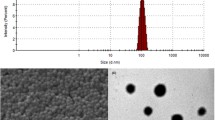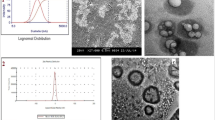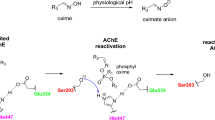Abstract
Purpose. To investigate the mechanism underlying the entry of the analgesic peptide dalargin into brain using biodegradable polybutylcyanoacrylate (PBCA) nanoparticles (NP) overcoated with polysorbate 80.
Methods. The investigations were carried out with PBCA NP and with non biodegradable polystyrene (PS) NP (200 nm diameter). Dalargin adsorption was assessed by HPLC. Its entry into the CNS in mice was evaluated using the tail-flick procedure. Locomotor activity measurements were performed to compare NP toxicities. BBB permeabilization by PBCA NP was studied in vitro using a coculture of bovine brain capillary endothelial cells and rat astrocytes.
Results. Dalargin loading was 11.7 µg/mg on PBCA NP and 16.5µg/ mg on PS NP. Adding polysorbate 80 to NP led to a complete desorption. Nevertheless, dalargin associated with PBCA NP and polysorbate 80 induced a potent and prolonged analgesia, which could not be obtained using PS NP in place of PBCA NP. Locomotor activity dramatically decreased in mice dosed with PBCA NP, but not with PS NP. PBCA NP also caused occasional mortality. In vitro, PBCA NP (10 µg/ml) induced a permeabilization of the BBB model.
Conclusions. A non specific permeabilization of the BBB, probably related to the toxicity of the carrier, may account for the CNS penetration of dalargin associated with PBCA NP and polysorbate 80.
Similar content being viewed by others
REFERENCES
I. Tamai and A. Tsuji. Drug delivery through the blood brain barrier. Adv. Drug Del. Rev. 19:401-424 (1996)
A. L. Betz, G. W. Goldstein, and R. Katzman. Blood-brain-cerebrospinal fluid barriers. In G. J. Siegel et al. (eds.), Basic neurochemistry: molecular, cellular and medical aspects, 5th Ed., Raven Press Ltd, New York, 1994, pp. 681-699.
R. J. Tamargo and H. Brem. Drug delivery to the central nervous system: a review. Neurosurg. Quaterly 2:259-279 (1992)
J. Huwyler, D. Wu, and W. M. Pardridge. Brain drug delivery of small molecules using immunoliposomes. Proc. Natl. Acad. Sci. USA 93:14164-14169 (1996)
R. N. Alyautdin, E. B. Tezikov, P. Ramges, D. A. Kharkevitch, D. J. Begley, and J. Kreuter. Significant entry of tubocurarine into the brain of rats by adsorption to polysorbate 80-coated polybutylcyanoacrylate nanoparticles: an in situ brain perfusion study. J. Microencapsulation 15:67-74 (1998)
R. N. Alyautdin, V. E. Petrov, K. Langer, A. Bertold, D. A. Kharkevitch, and J. Kreuter. Delivery of loperamide across the blood-brain barrier with polysorbate 80-coated polybutylcyanoacrylate nanoparticles. Pharm. Res. 14:325-328 (1997)
R. Alyautdin, D. Gothier, V. Petrov, D. Kharkevitch, and J. Kreuter. Analgesic activity of the hexapeptide dalargin adsorbed on the surface of polysorbate 80-coated poly(butyl cyanoacrylate) nanoparticles. Eur. J. Pharm. Biopharm. 41:44-48 (1995)
J. Kreuter, V. E. Petrov, D. A. Kharkevitch, and R. N. Alyautdin. Influence of the type of surfactant on the analgesic effects induced by the peptide dalargin after its delivery across the blood-brain barrier using surfactant-coated nanoparticles. J. Contr. Rel. 40:81-87 (1997)
J. Kreuter, R. N. Alyautdin, D. A. Kharkevitch, and A. A. Ivanov. Passage of peptides through the blood-brain barrier with colloidal polymer particles (nanoparticles). Brain Res. 674:171-174 (1995)
S. D. Tröster, U. Müller, and J. Kreuter. Modification of the body distribution of poly(methyl methacrylate) nanoparticles in rats by coating with surfactants. Int. J. Pharm. 61:85-100 (1990)
P. M. Friden. Utilization of an endogenous cellular transport system for the delivery of therapeutics across the blood-brain barrier. J. Contr. Rel. 46:117-128 (1996)
J. C. Olivier, M. Taverna, C. Vauthier, P. Couvreur, and D. Baylocq-Ferrier. Capillary electrophoresis monitoring of the competitive adsorption of albumin onto the orosomucoid-coated polyisobutylcyanoacrylate nanoparticles. Electrophoresis 15:234-239 (1994)
B. Kante, P. Couvreur, G. Dubois-Krack, C. De Meester, P. Guiot, M. Roland, M. Mercier, and P. Speiser. Toxicity of polyalkylcyanoacrylate nanoparticles I: free nanoparticles. J. Pharm. Sci. 71: 786-790 (1982)
P. Couvreur, B. Kante, M. Roland, P. Guiot, P. Bauduin, and P. Speiser. Polycyanoacrylate nanocapsules as potential lysosomotropic carriers: preparation, morphological and sorptive properties. J. Pharm. Pharmacol. 31:331-332 (1979)
F. E. D'Amour and D. L. Smith. A method for determining loss of pain sensation. J. Pharmacol. Exp. Ther. 72:74-79 (1941)
T. E. King, R. L. Joynes, and J. W. Grau. Tail-flick test: II. the role of supraspinal systems and avoidance learning. Behav. Neurosci. 4:754-767 (1997)
M. P. Dehouck, S. Méresse, P. Delorme, J. C. Fruchart, and R. Cecchelli. An easier, reproducible, and mass-production method to study the blood-brain barrier in vitro. J. Neurochem. 54:1798-1801 (1990)
A. Siflinger-Birnboim, P. J. Del Becchio, J. A. Cooper, F. A. Blumenstock, J. N. Shepard, and A. B. Malik. Molecular sieving characteristics of the cultured endothelial monolayer. J. Cell. Physiol. 132:111-117 (1987)
C. Lherm, R. H. Müller, F. Puisieux, and P. Couvreur. Alkylcyanoacrylate drug carriers: II. Cytotoxicity of cyanoacrylate nanoparticles with different alkyl chain length. Int. J. Pharm. 84:13-22 (1992)
R. H. Müller, C. Lehrm, J. Herbort, and P. Couvreur. In vitro model for the degradation of alkylcyanoacrylate nanoparticles. Biomaterials 11:65-85 (1990)
R. H. Müller, C. Lehrm, J. Herbort, T. Blunk, and P. Couvreur. Alkylcyanoacrylate drug carriers: I. Physicochemical characterization of nanoparticles with different alkyl chain length. Int. J. Pharm. 84:1-11 (1992)
L. Grislain, P. Couvreur, V. Lenaerts, M. Roland, D. Deprez-Decampeneere, and P. Speiser. Pharmacokinetics and distribution of a biodegradable drug-carrier. Int. J. Pharm. 15:335-345 (1983)
R. Fernandez-Urrusuno, E. Fattal, D. Porquet, J. Feger, and P. Couvreur. Evaluation of liver toxicological effects induced by polyalkylcyanoacrylate nanoparticles. Toxicol. Appl. Pharmacol. 130:272-279 (1995)
S. S. Davis and L. Illum. The targeting of drugs using polymeric microspheres. Br. Polym. J. 15:160-164 (1983)
F. L. S. Tse. Pharmacokinetics in drug discovery and development: nonclinical studies. In P. G. Welling and F. L. S. Tse (eds.), Pharmacokinetics: Regulatory, Industrial, Academic perspectives, 2nd ed., Marcel Dekker, New York, 1995, pp. 281-334.
M. N. Azmin, J. F. B. Stuart, and A. T. Florence. The distribution and elimination of methotrexate in mouse blood and brain after concurrent administration of polysorbate 80. Cancer Chemother. Pharmacol. 14:238-242 (1985)
J. C. Olivier, C. Vauthier, M. Taverna, F. Puisieux, D. Ferrier, and P. Couvreur. Stability of orosomucoid-coated polyisobutylcyanoacrylate nanoparticles in the presence of serum. J. Contr. Rel. 40:157-168 (1996)
Author information
Authors and Affiliations
Corresponding author
Rights and permissions
About this article
Cite this article
Olivier, JC., Fenart, L., Chauvet, R. et al. Indirect Evidence that Drug Brain Targeting Using Polysorbate 80-Coated Polybutylcyanoacrylate Nanoparticles Is Related to Toxicity. Pharm Res 16, 1836–1842 (1999). https://doi.org/10.1023/A:1018947208597
Issue Date:
DOI: https://doi.org/10.1023/A:1018947208597




